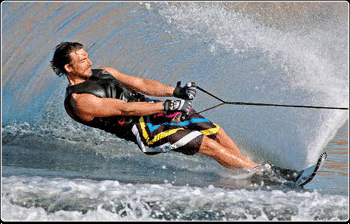
The Balanced Approach
One of the most common errors I see with slalom skiers is pushing the ski to where the skier wants it to go. An example of this is when a skier makes a poor turn and the ski falls too far behind. As the skier enters the wakes, he or she tightens every muscle in their body and shoves the ski forward. This gives an instant feeling of recovery and safety, but what the skier soon finds out is that they are in an extremely poor position to make the next turn. More often than not, the same poor turn will result and another ski push through the wakes will seem necessary. Letís take a look at why this happens and then how to get away from this habit.
An efficient turn has no upper body rotation from the apex through the completion of the turn. Most skiers, including myself, use upper body rotation to slide the back end of the ski around (skid turn). The problem with excessive skidding is that the ski turns too much and points in a direction that we cannot travel. You cannot turn 90 degrees and expect to be able to maintain that direction for very long. What we have learned to do in these excessive skidding situations is to lean on the back arm (left arm when traveling from the driverís side to the passengerís side) and fight to hold onto what direction we can. This unbalanced approach leads to a substantial increase in line pressure felt by the skier as they approach the wakes. This pressure cannot be maintained, so something has to give or the skier will crash. The common correction is to relieve the pressure by early edge changing. This is done by over-loading the back arm and shoving the feet forward. For an instant, it feels as though everything is great. The problem with this approach is that early edge change robs us of necessary width. Instead of having considerable space between you and the buoy (the most amazing part of watching pro skiers in my opinion), you are on a direct line at the buoy! No real preturn can happen because if it were to, you would not make the buoy. I think you can see whatís about to happen at the completion of this turn, so I will stop. And that is what you need to do as well. Stop choosing to beat yourself up for little or no positive return.
An efficient turn has no upper body rotation from the apex through the completion of the turn. I would like you to spend some time on this thought. The less we skid in this phase of the turn, the less water speed we will lose. We will be traveling at a faster speed when we start to accelerate, so we will end faster. Speed is defined as distance over time. If we cover more distance in the same amount of time, we will arrive earlier to the next buoy.
So back to our solution. From the apex, think of skiing into the handle with no rotation. The trick is to spend a longer time skiing to the handle. I did not use the term ďturningĒ to the handle on purpose. Remember that our focal point from apex to the handle is maintaining speed, not turning. This takes trust (youíre going to think you wonít make the next buoy). As your outside hand skis onto the handle, focus on the handle being low (below the belly button) and having a balance of pressure in your hands. Forget about pushing on the ski, just feel the pressure running through your hands. If one hand feels like it is harnessing more load, then shift. To do this, relax the overloaded hand (slightly open it) and flex the under-pressured hand. As long as you leave the ski out of the equation, you can shift at will. This leveling out of pressure will move your body to a balanced and sustainable position; a position that we can maintain all the way through the second wake. This is a very simple idea that takes a lot of practice to trust. A low handle with even hand pressure will allow more body weight to be supported off the edge of your ski without adding more strain on your muscles. It will actually feel like you are doing considerably less work and getting more space into the following buoy.

















